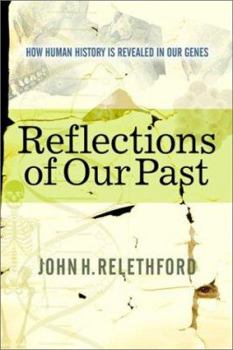Reflections of Our Past: How Human History Is Revealed in Our Genes
Select Format
Select Condition 
Book Overview
The rise of the multi-billion dollar ancestry testing industry points to one immutable truth about us as human beings: we want to know where we come from and who our ancestors were. John H. Relethford... This description may be from another edition of this product.
Format:Hardcover
Language:English
ISBN:0813339588
ISBN13:9780813339580
Release Date:May 2003
Publisher:Basic Books
Length:272 Pages
Weight:1.10 lbs.
Dimensions:0.9" x 6.2" x 9.3"
Customer Reviews
3 ratings
cool and clear thinking about human genetic diversity
Published by Thriftbooks.com User , 19 years ago
Ever since Cann, Stoneking and Wilson published their pathbreaking reconstruction of the history of human mitochondrial DNA in 1987, there has been a large amount of research attempting to use geographical patterns of human genetic diversity to throw light on human prehistory. Of all the books written for the layman that review progress in the field, this one is the best. Relethford avoids the triumphalism and groupthink that tends to characterize a lot of writing in this field. He is careful not to confuse the history of particular genes with the history of the populations in which these genes are found. As he explains it, whatever historical inferences are made from genetic patterns are highly dependent on the investigator's assumptions about demographic history and these assumptions are often made without justification. The author has himself contributed to much of the research described in the book. His studies of genetic history in Ireland are particular fascinating.He also includes a valuable discussion of the complex relationships between biological descent and ethnic identity; a subject upon which people are frequently confused. I would recommend this book without reservation to anyone interested in the subject.
Such a fine balance
Published by Thriftbooks.com User , 19 years ago
Labelling this work as "balanced" is a minimal descriptive. Relethford seeks to explain and reconcile some of the major themes in human evolution. Each topic is introduced with a presentation of "traditional" views. These are lined out fully and each seems to have sufficient support for a conclusive case. Relethford has been busy keeping up with the latest research, and the remainder of each section relates much of that. By the end of each section, it's clear that the old view has been successfully challenged. However, as the author frequently points out, many questions remain open. Little of this book provides final answers. He wants more work done. Much of the book is an appeal for newcomers to the field to find opportunities. No approach is better suited to gaining an understanding of the path humanity has taken in its spread around the planet. Relethford's style keeps your attention on the topics. He presents the information clearly and succinctly. The flow is good and requires little "back-flipping" to understand what he's trying to accomplish. As a geneticist, his focus is on gene indicators. The fossil record, while providing a firm foundation, is clearly not definitive in his view. It is the genetic record of humanity that has provided the clearest picture of how and when humans came out of Africa to populate the world. Fossils are a guide, but the path is better marked by gene markers. They offer a more complete picture of our wanderings."More complete" doesn't do justice to Relethford's approach. He lacks the dogmatic approach of many of his colleagues. The balanced treatment makes this book especially valuable, particularly to one new to the topics. As the book progresses the focus becomes ever tighter. After giving a general description of African origins, he summarises our knowledge of the Neandertals. Co-existent with our species, he considers the questions of species identity, the possibilities of interbreeding with Homo sapiens and extinction. In a related section he considers the onset of agriculture - did it spread from a single point of origin, or emerge in dispersed locations? He also examines the origins and progress of Native Americans and Polynesians. Closing the book with pinpoint examples, he explains the genetic history of islands on the Eire coast and the relationship of Jewish population elements. The historical issues are examined and countervailing ideas set against them.Relethford provides a fine range of illustrations, including maps and analytical graphs to expand on the text. Some of these require close attention as they simplify some rather complex analytical techniques. The captions, in many cases, are essential - which doesn't detract from the information value. The References are almost entirely academic, making tracing difficult for the general reader for whom this book was produced. [stephen a. haines - Ottawa, Canada]
A Good Overview for the Layperson
Published by Thriftbooks.com User , 20 years ago
The author is to be commended for a very understandable book for the layman on this subject. He expertly describes the methods researchers use in analyzing genetic data without overwhelming the layperson (like myself) with unnecessary details. He includes just enough of the details to make things understandable. I appreciate this.I also appreciate his caution in drawing conclusions from the data too soon. It seems to me that the author does not say, "This is the way it was." Rather he says, "This hypothesis is supported by the data, but another hypothesis may also be supported by the data if viewed from another perspective. More research is required." I would recommend this book to anyone who is trying to better understand the scientific method.




